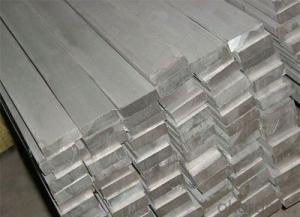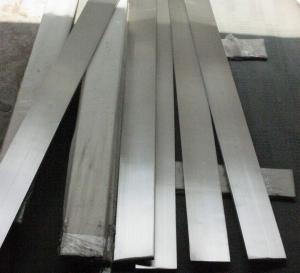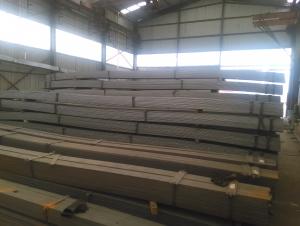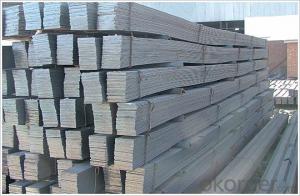Q235 Hot Rolled Steel Flat Bar
- Loading Port:
- Tianjin
- Payment Terms:
- TT OR LC
- Min Order Qty:
- -
- Supply Capability:
- 100000 m.t./month
OKorder Service Pledge
OKorder Financial Service
You Might Also Like
Specification of High Quality Flat Bar
Commodity: High Quality Flat Bar
Standard: GB;ASTM;JIS
Material: Q195-Q235;SS400;
Brand name: FLATSPACE
Origin place: China
Thickness: 3mm-30mm
Width:20mm-200mm
Length: Max 12m
Certification: SGS/BV
Chemical composition of Q235
Alloy No | Grade | Element(%) | ||||
C
| Mn
| S
| P
| Si
| ||
Q235
|
B
|
0.12—0.20 |
0.3—0.7 |
≤0.045 |
≤0.045
|
≤0.3
|
Physical properties of Q235
Alloy No | Grade | Yielding strength point(Mpa) | Tensile strength (Mpa) | Elongation after fracture(%) | ||||||
Thickness (mm) | Thickness (mm) | |||||||||
≤16 | >16--40 | >40--60 | >60--100 |
| ≤16 | >16--40 | >40--60 | >60--100 | ||
≥ | ≥ | |||||||||
Q235 |
B |
235 |
225 |
215 |
205 |
375--500 |
26 |
25 |
24 |
23 |
Usage/Applications of High Quality Flat Bar
Widely used for construction,
Machinery manufacturing,
Iron tower steel structure,
Shipbuilding;
Steel grating,
Staircase,
Bridge,
Viaduct,
Railway spare parts,
Boilers making etc.
Production Flow of High Quality Flat Bar
The steel flat bar is made through three processes:
1.Feeding the material: Feeding the row material (the steel plate) to Slitting Line.
2.Slitting:The steel plate would be slitted into expected width by lengthways cutter.
3. Leveled and cutting: The plat bar would be ground into level by the grinder and then cut into required length.
Packaging & Delivery of High Quality Flat Bar
Packaging Details: The Steel Flat Bars are packed in bundles and loaded in 20 feet/40 feet container, or shipped by bulk cargo ,also we can do as customer's requirements.
Delivery Details:30~45 days upon the receipt of buyer payment by T.T. or L/C.
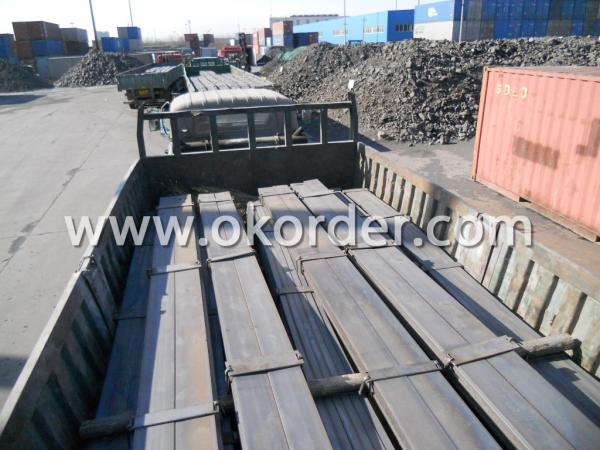


- Q:Can steel flat bars be used in the manufacturing of agricultural machinery?
- Yes, steel flat bars can be used in the manufacturing of agricultural machinery. Steel flat bars are versatile and durable, making them suitable for various applications in the agricultural industry. They can be used to construct frames, supports, brackets, and other structural components of agricultural machinery such as tractors, combines, tillers, and harvesters. The high strength and rigidity of steel flat bars ensure the durability and longevity of the machinery, even in harsh agricultural environments. Additionally, steel flat bars can be easily welded, bent, and shaped to meet specific design requirements, making them a preferred choice in agricultural machinery manufacturing.
- Q:What is the typical width-to-thickness ratio for steel flat bars?
- The typical width-to-thickness ratio for steel flat bars can vary depending on the specific application and industry standards. However, a common range for this ratio is typically between 10:1 to 20:1, where the width of the bar is 10 to 20 times greater than its thickness.
- Q:How do I choose the right size of steel flat bar for my project?
- To choose the right size of steel flat bar for your project, you should consider factors such as the load-bearing capacity required, the dimensions of the project, and any specific design requirements. It is essential to consult with a structural engineer or an expert in steel fabrication to ensure that the chosen size can adequately support the intended weight and meet the project's specifications.
- Q:Can steel flat bars be used for architectural purposes?
- Certainly, architectural purposes can definitely benefit from the utilization of steel flat bars. Steel, being a versatile and durable material, can be easily shaped and manipulated, making it an ideal choice for a variety of architectural applications. In architectural designs, steel flat bars are commonly employed to provide structural support, such as in the construction of beams, columns, and frames. Moreover, they can serve decorative purposes as well, imparting a modern and industrial aesthetic to buildings and structures. Additionally, steel flat bars offer architects the opportunity to create architectural elements like handrails, stairs, and balustrades, which not only enhance functionality but also add to the overall visual appeal. To sum up, the extensive range of possibilities offered by steel flat bars in terms of both structural and decorative applications make them an invaluable resource for architects and designers within the field of architecture.
- Q:Are steel flat bars suitable for welding applications?
- Steel flat bars are well-suited for welding purposes, given their versatility and strength. They are commonly utilized in welding projects due to their ability to be easily welded with various techniques like MIG, TIG, or arc welding. The flat surface of steel flat bars provides a stable base for welding, ensuring precise and accurate welds. These bars are extensively employed in construction, manufacturing, and fabrication sectors for diverse applications such as building frames, supports, brackets, and reinforcement. Furthermore, steel flat bars come in different grades and sizes, allowing for customization to meet specific welding requirements. Overall, steel flat bars are a dependable and favored option for welding applications.
- Q:Is the laying of a 40X4 flat steel for fire fighting metal trunking?
- The angle between the bridge is connected or welded together by rivets, but in accordance with the relevant provisions of the State Grid, not admit that these are valid connection. At the same time in order to protect the ground, must have a grounding cable connection between all seams of metal objects, so that it can recognize all of its bridge is connected to one end, through one or a plurality of total grounding grounding.
- Q:Are steel flat bars suitable for making architectural screens or grilles?
- Yes, steel flat bars are suitable for making architectural screens or grilles. They are strong, durable, and can be easily manipulated to create intricate designs. Additionally, steel is a versatile material that can withstand various weather conditions, making it an ideal choice for outdoor architectural features.
- Q:What is the bending capacity of a steel flat bar?
- The bending capacity of a steel flat bar refers to its ability to withstand bending forces without breaking or deforming permanently. The bending capacity is influenced by several factors, including the dimensions, thickness, and composition of the steel, as well as the applied load and the type of bending being performed. Steel flat bars typically have a high bending capacity due to their inherent strength and durability. The specific bending capacity of a steel flat bar can be determined by calculating the maximum bending moment it can withstand before failure occurs. This can be done using engineering formulas and principles, such as the moment of inertia and the yield strength of the steel. It is important to note that the bending capacity of a steel flat bar can vary depending on its specific grade or alloy. Different grades of steel have different mechanical properties, such as tensile strength and yield strength, which directly impact their bending capacity. Therefore, it is crucial to consider the specific grade and composition of the steel flat bar when determining its bending capacity. Additionally, the shape and dimensions of the steel flat bar also play a significant role in its bending capacity. Wider and thicker flat bars generally have higher bending capacities compared to narrower and thinner ones. This is because the increased cross-sectional area provides more resistance against bending forces. In summary, the bending capacity of a steel flat bar is determined by various factors, including the grade of steel, dimensions, and applied load. To accurately determine the bending capacity, it is recommended to consult engineering references or professionals who can perform calculations based on the specific properties of the steel flat bar in question.
- Q:What are the weight and load-bearing capacities of different steel flat bar sizes?
- The weight and load-bearing capacities of different steel flat bar sizes vary depending on the specific dimensions and quality of the steel used. Generally, larger and thicker flat bars have higher weight and load-bearing capacities. To determine the exact capabilities, it is necessary to consult engineering tables or reference materials that provide specific load ratings for different steel flat bar sizes.
- Q:Can steel flat bars be used for making lifting or rigging equipment?
- Steel flat bars can be used for making lifting or rigging equipment to some extent, depending on the specific application and requirements. Steel flat bars are known for their high strength and durability, making them suitable for certain lifting or rigging applications. However, it is essential to consider various factors such as the load capacity, working conditions, and safety requirements before using steel flat bars in such equipment. When using steel flat bars for lifting or rigging equipment, it is crucial to ensure that the bars meet the necessary strength and load-bearing specifications. The dimensions, thickness, and quality of the steel flat bars should be carefully considered to ensure they can withstand the expected loads and stresses. Additionally, it is important to understand that the shape and design of lifting or rigging equipment are critical for safe and efficient operation. Steel flat bars may be suitable for applications where a straight and flat shape is required, such as in certain lifting beams, brackets, or supports. However, in applications where dynamic or complex movements are involved, it may be more appropriate to use specialized shapes or components specifically designed for rigging purposes. Moreover, compliance with relevant safety standards and regulations is paramount when using steel flat bars for lifting or rigging equipment. It is essential to consult with experts or engineers who specialize in rigging and lifting to ensure that the equipment is designed and manufactured to meet the necessary safety requirements. In conclusion, steel flat bars can be used for making lifting or rigging equipment, but it is crucial to consider the specific application, load capacity, working conditions, and safety requirements. Consulting with professionals and adhering to relevant safety standards are essential steps to ensure the safe and efficient use of steel flat bars in lifting or rigging operations.
1. Manufacturer Overview |
|
|---|---|
| Location | |
| Year Established | |
| Annual Output Value | |
| Main Markets | |
| Company Certifications | |
2. Manufacturer Certificates |
|
|---|---|
| a) Certification Name | |
| Range | |
| Reference | |
| Validity Period | |
3. Manufacturer Capability |
|
|---|---|
| a)Trade Capacity | |
| Nearest Port | |
| Export Percentage | |
| No.of Employees in Trade Department | |
| Language Spoken: | |
| b)Factory Information | |
| Factory Size: | |
| No. of Production Lines | |
| Contract Manufacturing | |
| Product Price Range | |
Send your message to us
Q235 Hot Rolled Steel Flat Bar
- Loading Port:
- Tianjin
- Payment Terms:
- TT OR LC
- Min Order Qty:
- -
- Supply Capability:
- 100000 m.t./month
OKorder Service Pledge
OKorder Financial Service
Similar products
New products
Hot products
Related keywords














